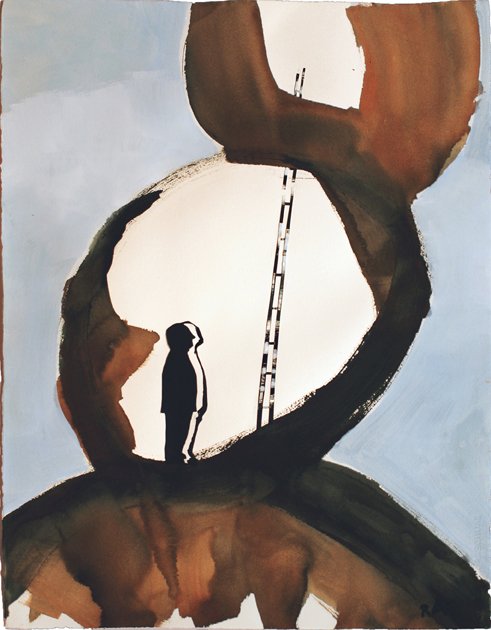Drawing Upon Finnegans Wake
DOI:
https://doi.org/10.18432/ari29381Keywords:
visual art, James Joyce, Finnegans Wake, transmediation, intertextualityAbstract
LOTS OF FUN WITH FINNEGANS WAKE is my six-year project to annotate / illustrate / disrupt the 628 pages of James Joyce’s final book. I’ve been reading Finnegans Wake off and on for about 40 years, and I consider it to be the most multi-layered, protean, and playful collection of words that we have. As a way to explore the book’s circular, recurring, enigmatic pathways, I am involved in the process of transmediation – I am turning some of its words into visual images and some of its linguistic images into words. This project is a way for me to indulge my natural inclination to connect the intellectual and the illustrative, the visual and the verbal.References
Carroll, Lewis (1983). Through the Looking-Glass, and what Alice found there, illustrated by Barry Moser, preface and notes by James R. Kincaid. Berkeley: University of California Press, 13.
Cicero, Marcus Tullius (1855). De Oratore, translated by J. S. Watson. London: Henry G. Bohn, 327.
de Hamel, Christopher (2017). Meetings with Remarkable Manuscripts. New York: Penguin, 136.
Deleuze, Gilles, and Félix Guattari (2009). Anti-Oedipus: Capitalism and Schizophrenia, preface by Michel Foucault, introduction by Mark Seem, translated by Robert Hurley, Mark Seem, and Helen R. Lane. New York: Penguin.
Ellmann, Richard (1983). James Joyce, New and Revised Edition. New York: Oxford University Press, 590.
Hassan, Ihab (1987). The Postmodern Turn. Columbus: Ohio State University Press, 116.
Heidegger, Martin (2008). Being and Time, translated by John Macquarrie and Edward Robinson, with a new forward by Taylor Carman. New York: Harper & Row.
Joyce, James (1992). Finnegans Wake, with an introduction by Seamus Deane. New York: Penguin, vii.
Joyce, James (2012). Finnegans Wake, edited by Robbert-Jan Henkes, Erik Binddervoet, and Finn Fordam. Oxford: Oxford University Press, 243:1.
Joyce, James (1975). Selected Joyce Letters, edited by Richard Ellmann. New York: Viking Press, 284.
Kristeva, Julia (1994). The Old Man and the Wolves. New York: Columbia University Press, 5.
Manguel, Alberto (1996). A History of Reading. New York: Viking, 249.
McHugh, Roland (2016). Annotations to Finnegans Wake, Fourth Edition. Baltimore: Johns Hopkins University Press.
McLuhan, Marshall (1967). Retrieved 15 July 2018 from https://www.youtube.com/watch?v=2JIj0Bqbdhk
Morwood, James (2005). Pocket Oxford Latin Dictionary. Oxford: Oxford University Press.
Moore, Alan (2016). Jerusalem. New York: Liveright Publishing.
O’Brien, Peter (2 April 2016 - ). LOTS OF FUN WITH FINNEGANS WAKE. Archival felt pen, acrylic, graphite, archival glitter glue, found objects, bodily fluids and humours, on 8 ½ X 11 archival card stock. Information on published pages can be found at https://tpob.me/lots-of-fun-with-finnegans-wake/
Partridge, Eric (1972). The Penguin Dictionary of Historical Slang, abridged by Jacqueline Simpson. Harmondsworth: Penguin.
Ovid (2004). Metamorphoses, translated and with notes by Charles Martin. New York: W. W. Norton, 2004, 31.
Siegel, Marjorie (1995). “More than Words: The Generative Power of Transmediation for Learning,” Canadian Journal of Education / Revue canadienne de l’éducation, Vol. 20, No. 4.
Steiner, George (1998). After Babel: Aspects of Language andTranslation, Third Edition. Oxford: Oxford University Press, 199.
Sterne, Laurence (2003). The Life and Opinions of Tristram Shandy, Gentleman. London: Penguin.
Published
How to Cite
Issue
Section
License
Copyright (c) 2018 Art/Research International: A Transdisciplinary Journal

This work is licensed under a Creative Commons Attribution-NonCommercial-NoDerivatives 4.0 International License.
Authors who publish with Art/Research International agree to the following terms:
a. Authors retain copyright and grant the journal right of first publication and the right to sublicense the Contribution, in the form in which it is published by the journal, to others under the terms and conditions of the of the Creative Commons Attribution-NonCommercial-NoDerivs (CC BY-NC-ND) that allows others to download the work and share the work with others with an acknowledgement of the work's authorship and initial publication in this journal, but they cannot change the work in any way or use any part of the work commercially.
b. Authors are able to enter into separate, additional contractual arrangements for the non-exclusive public distribution and display of the journal's published version of the work (e.g., post it to an institutional repository or publish it in a book), with an acknowledgement of its initial publication in this journal.
c. Authors are permitted and encouraged to post their work online (e.g., in institutional repositories or on their website) prior to and during the submission process, as it can lead to productive exchanges, as well as earlier and greater citation of published work (See The Effect of Open Access).
d. Authors wishing to include items (such as images or other media, or any creative works of others whether previously published or not) must contact the original copyright holder to obtain explicit permission to publish these items in Art/Research International. Writing permission should include: the title(s) of any copyrighted work, original place of publication if applicable, and an acknowledgement of having read Art/Research International's copyright notice. Authors are responsible for obtaining this permission and keeping it in their own records for later verification.



